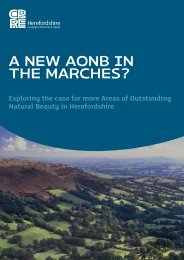Generating light on landscape impacts - Campaign to Protect Rural ...
Generating light on landscape impacts - Campaign to Protect Rural ...
Generating light on landscape impacts - Campaign to Protect Rural ...
- No tags were found...
You also want an ePaper? Increase the reach of your titles
YUMPU automatically turns print PDFs into web optimized ePapers that Google loves.
Return <strong>to</strong> c<strong>on</strong>tents1424. <strong>Protect</strong>i<strong>on</strong> afforded <strong>to</strong> the Green Belt poses a similar problem.The defining characteristic of Green Belt protecti<strong>on</strong> is retaining the‘openness’ of areas surrounding major <strong>to</strong>wns and cities. 24 The Nati<strong>on</strong>alPlanning Policy Framework states that local planning authoritiesshould look <strong>to</strong> retain and enhance <strong>landscape</strong>s and that manyrenewable energy projects will comprise inappropriate developmentwithin the Green Belt. Any developments would therefore need <strong>to</strong>dem<strong>on</strong>strate ‘very special circumstances’ that clearly outweigh anyharm caused, including <strong>landscape</strong> impact. Very special circumstances,however, may include producti<strong>on</strong> of energy from renewable sources(see case study 3) high<str<strong>on</strong>g>light</str<strong>on</strong>g>ing a clear c<strong>on</strong>tradicti<strong>on</strong> in policy objectives.Case study 3: Green BeltsLand at Hook Moor, Leeds, had permissi<strong>on</strong> for five wind turbinesand associated infrastructure granted <strong>on</strong> appeal in 2011 (seeAnnex 1). The local planning authority rejected the originalapplicati<strong>on</strong>. An appeal was subsequently dismissed because theInspec<strong>to</strong>r c<strong>on</strong>sidered that the development would unacceptablyharm the openness of the Green Belt. It was c<strong>on</strong>sidered that theapplicati<strong>on</strong> c<strong>on</strong>flicted with advice given <strong>on</strong> protecti<strong>on</strong> of theGreen Belt in Planning Policy Guidance Note 2 and its generalpresumpti<strong>on</strong> against ‘inappropriate development’. A High Courtruling, however, granted the developer a sec<strong>on</strong>d appeal becausethe Inspec<strong>to</strong>r at the time gave no weight <strong>to</strong> the then recentlyrevoked Regi<strong>on</strong>al Spatial Strategies – a revocati<strong>on</strong> which wassubsequently found <strong>to</strong> be unlawful.At the sec<strong>on</strong>d appeal the new Inspec<strong>to</strong>r agreed with the previousInspec<strong>to</strong>r that the development c<strong>on</strong>stitutes inappropriatedevelopment in the Green Belt attracting ‘substantial weight’.The Inspec<strong>to</strong>r also agreed that the loss of openness in the areawould be ‘c<strong>on</strong>siderable’ because it would cause harm <strong>to</strong> thecharacter of the <strong>landscape</strong>. The Inspec<strong>to</strong>r, however, approved theappeal. In reaching his decisi<strong>on</strong> he high<str<strong>on</strong>g>light</str<strong>on</strong>g>ed the recent andgrowing set of nati<strong>on</strong>al policies <strong>on</strong> renewable energy and thestr<strong>on</strong>g nati<strong>on</strong>al support for them. In the Inspec<strong>to</strong>r’s judgement,the new policy c<strong>on</strong>text justified reaching a different c<strong>on</strong>clusi<strong>on</strong> <strong>to</strong>the previous Inspec<strong>to</strong>r because the other c<strong>on</strong>siderati<strong>on</strong>s amounted<strong>to</strong> the ‘very special circumstances’ necessary <strong>to</strong> justify thedevelopment. It is not clear how judgements of this sort can berec<strong>on</strong>ciled with the very str<strong>on</strong>g localist emphasis in the Nati<strong>on</strong>alPlanning Policy Framework.25. Locally designated areas, while not enjoying nati<strong>on</strong>al level protecti<strong>on</strong>,are also particularly sensitive <strong>to</strong> inappropriate development. Theseareas are often designated because they represent a unique characterwithin a local area. CPRE recognises that the nati<strong>on</strong>al need for morerenewable energy will sometimes outweigh local level <strong>landscape</strong>designati<strong>on</strong>s, but we are c<strong>on</strong>cerned that it is <strong>to</strong>o often the Planning24Department for Communities and LocalGovernment, Nati<strong>on</strong>al Planning PolicyFramework, 2012<str<strong>on</strong>g>Generating</str<strong>on</strong>g> <str<strong>on</strong>g>light</str<strong>on</strong>g> <strong>on</strong> <strong>landscape</strong> <strong>impacts</strong>: How <strong>to</strong> accommodate <strong>on</strong>shore wind while protecting the countryside




